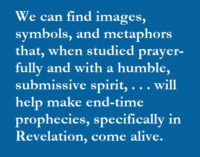During the First Gulf War (1991), a well-known Protestant writer and speaker was convinced that the book of Revelation predicted this conflict. His argument was based on the fact that some of the helicopters in the war looked like the locusts depicted in Revelation 9. “And he opened the bottomless pit, and smoke arose out of the pit like the smoke of a great furnace. So the sun and the air were darkened because of the smoke of the pit. Then out of the smoke locusts came upon the earth. And to them was given power, as the scorpions of the earth have power.” (Revelation 9:2, 3, NKJV).
Not exactly the best way to interpret biblical prophecy, is it? Yet, interpretations like this are fairly common. In fact, over the decades a stream of books, articles, videos, and now websites, all dedicated to prophecy, have made many predictions, including date setting, about final events—usually centered on wars or turmoil in the middle east.
As Seventh-day Adventists, we take a different approach, a Christ-centered approach, in which the focus of prophecy is no longer on a single geographic location in the Middle East and whatever military conflicts unfold there. Instead, we view the prophecies through the lens of the great controversy between Christ and Satan—a worldwide spiritual struggle that will climax when God’s people, Jew and Gentile (see Revelation 12;17, Revelation 14:12), face the final crisis, which centers on worshiping the Creator (see Revelation 14:7), as opposed to the beast and his image.
A key element in understanding these last-day prophecies is Daniel 2, which contains not only the historical outline of the prophecies but the interpretive key to unlocking their meanings, as well.
 Daniel 2 depicts four world empires—Babylon, Media-Persia, Greece, and Rome—followed by God’s establishing His eternal kingdom, “ ‘which shall never be destroyed, and the kingdom shall not be left to other people; it shall break in pieces and consume all these kingdoms, and it shall stand forever.’ ” (Daniel 2:44 NKJV). The parallel prophecies in Daniel 7 and 8 contain this same basic outline, that of these worldly empires arising and vanishing until God’s kingdom is forever established.
Daniel 2 depicts four world empires—Babylon, Media-Persia, Greece, and Rome—followed by God’s establishing His eternal kingdom, “ ‘which shall never be destroyed, and the kingdom shall not be left to other people; it shall break in pieces and consume all these kingdoms, and it shall stand forever.’ ” (Daniel 2:44 NKJV). The parallel prophecies in Daniel 7 and 8 contain this same basic outline, that of these worldly empires arising and vanishing until God’s kingdom is forever established.
In Daniel 7, the angel interpreter sets it all out for us “ ‘Those great beasts, which are four, are four kings which arise out of the earth. But the saints of the Most High shall receive the kingdom, and possess the kingdom forever, even forever and ever’ ” (Daniel 7:17, 18, NKJV).
Four worldly empires (Babylon, Media-Persia, Greece, and Rome) move in an unbroken succession through history until, after the second coming of Jesus, God established His eternal one.
Of course, we are still here, in the time of the division of Rome, the fourth and final earthly kingdom before Christ returns.
With this historical perspective as the foundation for understanding prophecy, we are going to study this quarter the theme of how to interpret Bible prophecy, specifically some of the allusions, stories, images and metaphors that unlock prophetic truth and final events.
We go from the Genesis creation account—important for understanding not only prophecy but for what follows, especially the cross and the atoning death of Jesus—to the tower of Babel, to the sanctuary service, to the Psalms, even to some Old Testament marriages. In all these, and more, we can find images, symbols, and metaphors that, when studied prayerfully and with a humble, submissive spirit (if you go to the Bible with a rebellious heart, you are wasting your time), will help make end-time prophecies, specifically in Revelation, come alive.
One quarter is certainly not enough even to begin to study all the stories and images that help unlock prophetic truth. Who knows—we might need eternity for that. Until then, by God’s grace, we will study what we can.
Shawn Boonstra is speaker/director for the Voice of Prophecy ministry. His broadcasts and books have been a source of inspiration around the globe, and over the years, his live evangelistic events have been presented on every continent except Antarctica.
 (0)
(0)Source: https://ssnet.org/blog/introduction-precursors-for-prophecy/




